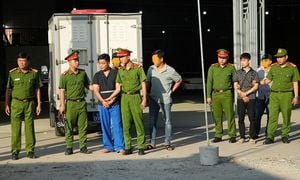On February 22, 2025, the long-awaited hostage exchange between Israel and Hamas unfolded, resulting in the release of six living Israeli captives. This was part of the first phase of negotiations following Hamas's attack on Israel on October 7, 2023, which sparked protracted conflict and negotiations aimed at alleviating the humanitarian crisis and stabilizing the fragile ceasefire.
Among the released hostages were Eliya Cohen, 27; Tal Shoham, 40; Omer Shem Tov, 22; and Omer Wenkert, 23—all taken during the October attack. Their return was met with emotional scenes as they were greeted by masked Hamas militants who proudly escorted them onto stages lined with supportive slogans before they were handed over to the Red Cross. Another two captives, Hisham Al-Sayed, 36, and Avera Mengistu, 39, had been held since they entered Gaza over nine years ago, under circumstances still not fully clear.
This exchange, intended to symbolize goodwill and progress, was overshadowed by growing tension as Israel prepared to release 602 Palestinian prisoners—a significant number marking the largest prisoner swap under the ceasefire agreement. Israeli Prime Minister Benjamin Netanyahu announced, though, the release would be delayed due to what he described as Hamas’s “humiliations” during these exchanges, including public ceremonies where hostages were paraded.
The Israeli government had expected to facilitate the release as previously outlined, but as Netanyahu stated, “We’ve decided to delay the release of terrorists until the next hostages’ release is assured, without humiliations.” His remark reflected growing concern over the presentation of hostages during the public ceremonies, which he referred to as “disgraceful.” Adding to the complexity is the emotional strained dynamic of these exchanges—a significant concern for families of all involved.
Families of Palestinian prisoners had been anxiously awaiting the announcement of their loved ones’ release, with many remaining uncertain as hours passed without communication. Umm Diya al-Agha, 80, whose son was reportedly among those planned for release after 33 years of imprisonment, expressed her deep mix of hope and anxiety, saying, “If my heart were made of iron, it would have melted and shattered. Every day, I have been waiting for this moment.”
The backdrop to these events included allegations from both sides following the recent exchanges. A particularly distressing incident involved the confusion around human remains initially returned by Hamas under the ceasefire agreement. Israeli authorities had expected the remains of Shiri Bibas and her two young sons, but upon inspection, concluded they were not among the bodies delivered. This sparked outrage and deepened mistrust between the two sides, leading Netanyahu to vow repercussions for Hamas’s actions.
Speaking on the mix-up, Hamas acknowledged there had been mistakes, attributing the situation to recovery efforts from rubble following Israeli airstrikes. They later returned additional human remains, which are now being subjected to forensic analysis for identification. These incidents deeply resonate with the trauma experienced by Israeli families and underline the intense emotional stakes these negotiations carry.
According to data from both Israeli and Palestinian health authorities, the October 7 attack by Hamas claimed at least 1,200 lives, with Israel's extensive military response leading to the deaths of more than 48,000 Palestinians, many of whom are reported to be civilians. The humanitarian crisis worsens daily, with hundreds of thousands displaced and reliant on international aid as the conflict drags on.
Both parties express intentions for future dialogue, indicating potential for another phase of negotiations aimed at solidifying peace and the resolution of remaining hostages' fates. Despite the apparent goodwill efforts initiated with the recent exchanges, the path forward remains obscured by severe distrust and entrenched animosities.
While families celebrate the return of their loved ones, the specter of continued violence looms. The emotional weight of these moments exemplifies the toll inflicted by years of conflict, with individuals and families caught between the machinations of leadership on both sides. The slow steps toward reconciliation and the promise of future negotiations paint only a partial picture—a picture filled with both hope and skepticism.
This complex dynamic continues to play out against the backdrop of international involvement and requests for peace, with observers noting the urgent need for both parties to prioritize dignity and respect for individual lives engulfed by the broader geopolitical struggle. The negotiations—burdened as they are by past grievances—will require sincere engagement from both sides if the hopes for peace are to materialize for those most affected by the conflict.



